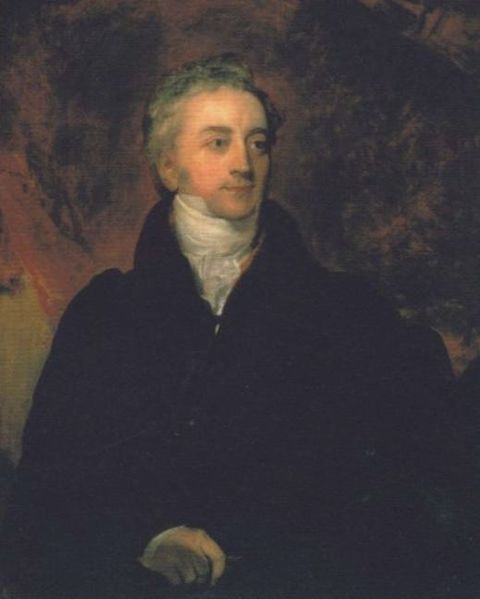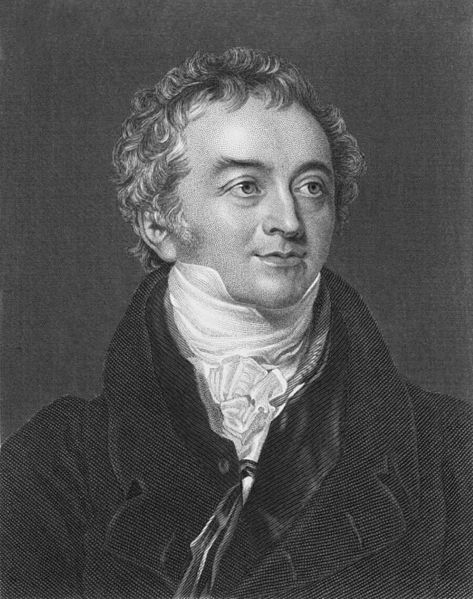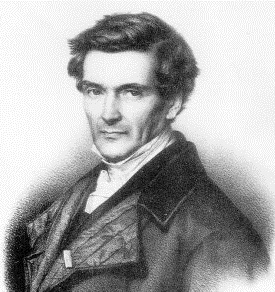<Back to Index>
- Physicist and Egyptologist Thomas Young, 1773
- Physicist and Engineer Gaspard - Gustave de Coriolis, 1792
PAGE SPONSOR


Thomas Young (13 June 1773 – 10 May 1829) was an English polymath. Young made notable scientific contributions to the fields of vision, light, solid mechanics, energy, physiology, language, musical harmony and Egyptology. He "made a number of original and insightful innovations" in the decipherment of Egyptian hieroglyphs (specifically the Rosetta Stone) before Jean - François Champollion eventually expanded on his work. He was admired by, among others, Herschel, Helmholtz, Maxwell and Einstein.
Young belonged to a Quaker family of Milverton, Somerset, where he was born in 1773, the eldest of ten children. At the age of fourteen Young had learned Greek and Latin and was acquainted with French, Italian, Hebrew, German, Chaldean, Syriac, Samaritan, Arabic, Persian, Turkish and Amharic.
Young began to study medicine in London in 1792, moved to Edinburgh in 1794, and a year later went to Göttingen, Lower Saxony, Germany where he obtained the degree of doctor of physics in 1796. In 1797 he entered Emmanuel College, Cambridge. In the same year he inherited the estate of his granduncle, Richard Brocklesby, which made him financially independent, and in 1799 he established himself as a physician at 48 Welbeck Street, London (now recorded with a blue plaque). Young published many of his first academic articles anonymously to protect his reputation as a physician.
In 1801 Young was appointed professor of natural philosophy (mainly physics) at the Royal Institution. In two years he delivered 91 lectures. In 1802, he was appointed foreign secretary of the Royal Society, of which he had been elected a fellow in 1794. He resigned his professorship in 1803, fearing that its duties would interfere with his medical practice. His lectures were published in 1807 in the Course of Lectures on Natural Philosophy and contain a number of anticipations of later theories.
In 1811 Young became physician to St. George's Hospital, and in 1814 he served on a committee appointed to consider the dangers involved in the general introduction of gas into London. In 1816 he was secretary of a commission charged with ascertaining the precise length of the second's or seconds pendulum (the length of a pendulum whose period is exactly 2 seconds), and in 1818 he became secretary to the Board of Longitude and superintendent of the HM Nautical Almanac Office.
A few years before his death he became interested in life insurance, and in 1827 he was chosen one of the eight foreign associates of the French Academy of Sciences. In 1828, he was elected a foreign member of the Royal Swedish Academy of Sciences.
Thomas Young died in London on 10 May 1829, and was buried in the cemetery of St. Giles Church in Farnborough, Kent, England. Westminster Abbey houses a white marble tablet in memory of Young bearing the epitaph by Hudson Gurney:
Sacred to the memory of Thomas Young, M.D., Fellow and Foreign Secretary of the Royal Society Member of the National Institute of France; a man alike eminent in almost every department of human learning. Patient of unintermitted labour, endowed with the faculty of intuitive perception, who, bringing an equal mastery to the most abstruse investigations of letters and of science, first established the undulatory theory of light, and first penetrated the obscurity which had veiled for ages the hieroglyphs of Egypt. Endeared to his friends by his domestic virtues, honoured by the World for his unrivalled acquirements, he died in the hopes of the Resurrection of the just. — Born at Milverton, in Somersetshire, June 13th, 1773. Died in Park Square, London, May 10th, 1829, in the 56th year of his age.
Later scholars and scientists have praised Young's work although they may know him only through achievements he made in their fields. His contemporary Sir John Herschel called him a "truly original genius". Albert Einstein praised him in the 1931 foreword to an edition of Newton's Opticks. Other admirers include physicist Lord Rayleigh and Nobel laureate Philip Anderson.
Thomas Young's name has been adopted as the name of the London - based Thomas Young Centre, an alliance of academic research groups engaged in the theory and simulation of materials.
In Young's own judgment, of his many achievements the most important was to establish the wave theory of light. To do so, he had to overcome the century old view, expressed in the venerable Isaac Newton's "Optics", that light is a particle. Nevertheless, in the early 19th century Young put forth a number of theoretical reasons supporting the wave theory of light, and he developed two enduring demonstrations to support this viewpoint. With the ripple tank he demonstrated the idea of interference in the context of water waves. With the Young's interference experiment, or double - slit experiment, he demonstrated interference in the context of light as a wave.
"The experiments I am about to relate ... may be repeated with great ease, whenever the sun shines, and without any other apparatus than is at hand to every one."
This is how Thomas Young speaking on November 24, 1803, to the Royal Society of London, began his description of the historic experiment. His talk was published in the following year's Philosophical Transactions, and was destined to become a classic, still reprinted and read today.
In the subsequent paper entitled Experiments and Calculations Relative to Physical Optics, published in 1804, Young describes an experiment in which he placed a narrow card (approx. 1/30th in.) in a beam of light from a single opening in a window and observed the fringes of color in the shadow and to the sides of the card. He observed that placing another card before or after the narrow strip so as to prevent light from the beam from striking one of its edges caused the fringes to disappear. This supported the contention that light is composed of waves. Young performed and analyzed a number of experiments, including interference of light from reflection off nearby pairs of micrometer grooves, from reflection off thin films of soap and oil, and from Newton's rings. He also performed two important diffraction experiments using fibers and long narrow strips. In his Course of Lectures on Natural Philosophy and the Mechanical Arts (1807) he gives Grimaldi credit for first observing the fringes in the shadow of an object placed in a beam of light. Within ten years, much of Young's work was reproduced and then extended by Fresnel. (Tony Rothman in Everything's Relative and Other Fables from Science and Technology argues that there is no clear evidence that Young actually did the two - slit experiment.)
Young described the characterization of elasticity that came to be known as Young's modulus, denoted as E, in 1807, and further described it in his Course of Lectures on Natural Philosophy and the Mechanical Arts.
However, the first use of the concept of Young's modulus in experiments was by Giordano Riccati in 1782 – predating Young by 25 years.
Furthermore, the idea can be traced back to a paper by Leonhard Euler published in 1727, some 80 years before Thomas Young's 1807 paper.
The Young's modulus relates the stress (pressure) in a body to its associated strain (change in length as a ratio of the original length); that is, stress = E × strain, for a uniaxially loaded specimen. Young's modulus is independent of the component under investigation; that is, it is an inherent material property (the term modulus refers to an inherent material property). Young's Modulus allowed, for the first time, prediction of the strain in a component subject to a known stress (and vice versa). Prior to Young's contribution, engineers were required to apply Hooke's F = kx relationship to identify the deformation (x) of a body subject to a known load (F), where the constant (k) is a function of both the geometry and material under consideration. Finding k required physical testing for any new component, as the F = kx relationship is a function of both geometry and material. Young's Modulus depends only on the material, not its geometry, thus allowing a revolution in engineering strategies.
Young has also been called the founder of physiological optics. In 1793 he explained the mode in which the eye accommodates itself to vision at different distances as depending on change of the curvature of the crystalline lens; in 1801 he was the first to describe astigmatism; and in his lectures he presented the hypothesis, afterwards developed by Hermann von Helmholtz, that color perception depends on the presence in the retina of three kinds of nerve fibers. This foreshadowed the modern understanding of color vision, in particular the finding that the eye does indeed have three color receptors which are sensitive to different wavelength ranges.
In 1804, Young developed the theory of capillary phenomena on the principle of surface tension. He also observed the constancy of the angle of contact of a liquid surface with a solid, and showed how from these two principles to deduce the phenomena of capillary action.
In 1805, Pierre - Simon Laplace, the French philosopher, discovered the significance of meniscus radii with respect to capillary action.
In 1830, Carl Friedrich Gauss, the German mathematician, unified the work of these two scientists to derive the Young – Laplace equation, the formula that describes the capillary pressure difference sustained across the interface between two static fluids.
Young was the first to define the term "energy" in the modern sense.
Young’s equation describes the contact angle of a liquid drop on a plane solid surface as a function of the surface free energy, the interfacial free energy and the surface tension of the liquid. Young’s equation was developed further some 60 years later by Dupré to account for thermodynamic effects, and this is known as the Young – Dupré equation.
In physiology Young made an important contribution to haemodynamics in the Croonian lecture for 1808 on the "Functions of the Heart and Arteries," and his medical writings included An Introduction to Medical Literature, including a System of Practical Nosology (1813) and A Practical and Historical Treatise on Consumptive Diseases (1815).
Young devised a rule of thumb for determining a child’s drug dosage. Young’s Rule states that the child dosage is equal to the adult dosage multiplied by the child’s age in years, divided by the sum of 12 plus the child’s age.
In an appendix to his Göttingen dissertation (1796; "De corporis hvmani viribvs conservatricibvs. Dissertatio.") there are four pages added proposing a universal phonetic alphabet (so as 'not to leave these pages blank'; lit.: "Ne vacuae starent hae paginae, libuit e praelectione ante disputationem habenda tabellam literarum vniuersalem raptim describere"). It includes 16 "pure" vowel symbols, nasal vowels, various consonants, and examples of these, drawn primarily from French and English.
In his Encyclopædia Britannica article "Languages", Young compared the grammar and vocabulary of 400 languages. In a separate work in 1813, he introduced the term Indo - European languages, 165 years after the Dutch linguist and scholar Marcus Zuerius van Boxhorn proposed the grouping to which this term refers in 1647.
Young was also one of the first who tried to decipher Egyptian hieroglyphs, with the help of a demotic alphabet of 29 letters built up by Johan David Åkerblad in 1802 (14 turned out to be incorrect), but Åkerblad wrongly believed that demotic was entirely alphabetic. "Dr Young, however, showed that neither the alphabet of Akerblad, nor any modification of it which could be proposed, was applicable to any considerable part of the enchorial portion of the Rosetta inscription beyond the proper names." By 1814 Young had completely translated the "enchorial" (demotic, in modern terms) text of the Rosetta Stone (he had a list with 86 demotic words), and then studied the hieroglyphic alphabet but initially failed to recognize that the demotic and hieroglyphic texts were paraphrases and not simple translations. Some of Young's conclusions appeared in the famous article "Egypt" he wrote for the 1818 edition of the Encyclopædia Britannica.
When the French linguist Jean - François Champollion in 1822 published a translation of the hieroglyphs and the key to the grammatical system, Young (and many others) praised his work. In 1823, Young published an Account of the Recent Discoveries in Hieroglyphic Literature and Egyptian Antiquities, in order to have his own work recognized as the basis for Champollion's system. In this, he made it clear that many of his findings had been published and sent to Paris in 1816. Young had correctly found the sound value of six signs, but had not deduced the grammar of the language. Champollion was unwilling to share the credit. In the ensuing schism, strongly motivated by the political tensions of that time, the British championed Young, while the French supported Champollion. Champollion maintained that he alone had deciphered the hieroglyphs, although his understanding of the hieroglyphic grammar showed the same mistakes made by Young. However, after 1826, when Champollion was a curator in the Louvre he did offer Young access to demotic manuscripts.
He developed Young temperament, a method of tuning musical instruments.

Gaspard - Gustave de Coriolis or Gustave Coriolis (21 May 1792 – 19 September 1843) was a French mathematician, mechanical engineer and scientist. He is best known for his work on the supplementary forces that are detected in a rotating frame of reference (Coriolis Effect). Coriolis was the first to coin the term "work" for the transfer of energy by a force acting through a distance.
Coriolis was born in Paris in 1792. In 1816 he became a tutor at the École Polytechnique, where he did experiments on friction and hydraulics.
In 1829 Coriolis published a textbook, Calcul de l'Effet des Machines ("Calculation of the Effect of Machines"), which presented mechanics in a way that could readily be applied by industry. In this period the correct expression for kinetic energy, ½mv2, and its relation to mechanical work became established.
During the following years Coriolis worked to extend the notion of kinetic energy and work to rotating systems. The first of his papers, Sur le principe des forces vives dans les mouvements relatifs des machines (On the principle of kinetic energy in the relative motion in machines), was read to the Académie des Sciences (1832). Three years later came the paper that would make his name famous, Sur les équations du mouvement relatif des systèmes de corps (On the equations of relative motion of a system of bodies). Coriolis's papers do not deal with the atmosphere or even the rotation of the earth, but with the transfer of energy in rotating systems like waterwheels. Coriolis discussed the supplementary forces that are detected in a rotating frame of reference and he divided these forces into two categories. The second category contained the force that would eventually bear his name.
In 1835 he published a mathematical work on collisions of spheres: Théorie Mathématique des Effets du Jeu de Billard, considered a classic on the subject.
Coriolis's name began to appear in the meteorological literature at the end of the 19th century, although the term "Coriolis force" was not used until the beginning of the 20th century. Today, the name Coriolis has become strongly associated with meteorology, but all major discoveries about the general circulation and the relation between the pressure and wind fields were made without knowledge about Gaspard Gustave Coriolis.
Coriolis became professor of mechanics at the École Centrale des Arts et Manufactures in 1829. Upon the death of Navier in 1836, Coriolis succeeded him in in the chair of applied mechanics at the École des Ponts and Chaussées and to Navier's place in the Académie des Sciences. In 1838 he succeeded Dulong as Directeur des études (director of studies) in the École Polytechnique.
He died in 1843 at the age of 51 in Paris. His name is one of the 72 names inscribed on the Eiffel Tower.